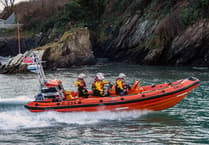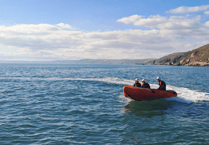AS LOCAL families and visitors start heading to the beach in greater number, the RNLI is urging everyone to be safe in and around the water.
Rip currents are the number one factor in incidents where people need lifeguard assistance, says the RNLI, and are a major cause of drowning around the world.
In recent weeks there have been multiple lifeguard rescues from rip currents off beaches in Whitsand Bay. Two people were taken to hospital after getting into trouble at Tregantle, and one one day, 16 swimmers and bodyboarders were rescued in separate incidents in the bay.
Meanwhile at Sandymouth in Bude last weekend, 12 year old junior lifeguard Alfie Turner spotted a family being swept out in a rip current and was first to paddle out to them, signalling for help and staying with the father of the group while lifeguards rescued the other family members.
RNLI Lifeguard supervisor for South East Cornwall Beau Gillet is giving the following advice to anyone going in the sea.
What are Rip currents?
Rips are strong currents running out to sea, which can quickly drag people and debris away from the shallows of the shoreline and out to deeper water.
They tend to flow at one-two mph but can reach four-five mph, which is faster than an Olympic swimmer!
Rips are especially powerful in larger surf, but never underestimate the power of the water. They are also found around river mouths, estuaries and man-made structures like piers and groynes.
How to spot and avoid a rip current:
Rip currents can be difficult to spot, but are sometimes identified by a channel of churning, choppy water on the sea’s surface.
Even the most experienced beachgoers can be caught out by rips, so don’t be afraid to ask lifeguards for advice. They will show you how you can identify and avoid rips.
The best way to avoid a rip current is to visit a lifeguarded beach and always swim between the red and yellow flags. This patrol area has been marked based on where is safer to swim in the current conditions. This also helps you to be spotted more easily, should something go wrong.
Types of rip current:
PERMANENT – remain in the same area for several months and even years. The sea’s surface and prevailing conditions change very little
FIXED – a hole or gully often accompanies these rips on the sea bed when water from the incoming tide increases between the shore and off-shore sand banks with sand as its primary base. These rips can last from several hours to a couple of months.
FLASH – temporary rip caused by a storm, rapid rise in sea level or heavy surf with long wave periods.
If you find yourself caught in a rip current:
- Always raise your hand and shout for help
- Do not try to swim against the rip or you’ll get exhausted
- If you can stand, wade through the water, don’t swim
- If you can, swim parallel to the shore until free of the rip and then head to the shore
- If you see anybody in trouble, alert the lifeguards immediately or call 999/112 and ask for the Coastguard
’This summer, we will not have as many lifeguard patrols as normal due to the Coronavirus pandemic,’ said Beau.
’Please choose to swim at a lifeguarded beach and check local weather warnings and advice to find out about hazards in your area.’
The beaches in Cornwall with an RNLI lifeguard service this summer are:
South East Cornwall: Seaton, Tregantle, Tregonhawke and Sharrow
North Cornwall: Widemouth, Sandymouth, Summerleaze, Crooklets, Porthcothan, Treyarnon, Constantine, Booby’s, Harlyn, Trevone, Polzeath, Watergate Bay, Mawgan Porth, Porth Beach, Towan, Fistral and Crantock
Perranporth area: Portreath, Porthtowan, Chapel Porth, St Agnes, Perranporth, Perran Sands and Holywell Bay
West Cornwall: Godrevy, Gwithian, Upton Towns, Beachviews, Hayle Towans, Porthminster, Porthmeor, Porthcurno, Sennen, Gwenver, Praa Sands, Poldhu, Kennack Sands and Gyllngvase




